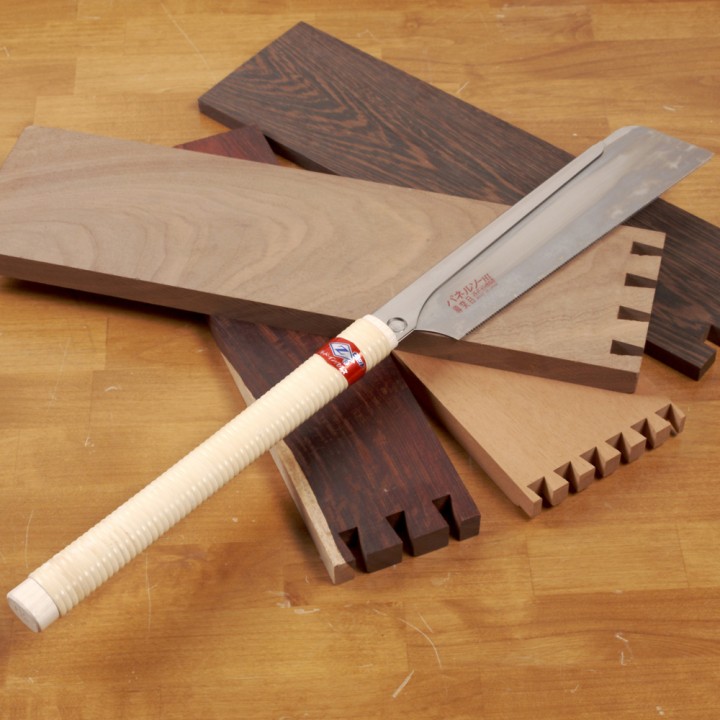 So my boss sends me this assignment: Write an article on Japanese Handsaws. “They seem to be trending now”, he says. I think to myself, “how can they be 'trending?' when a thing is good it's just good...is sliced bread a 'trend?'”
So my boss sends me this assignment: Write an article on Japanese Handsaws. “They seem to be trending now”, he says. I think to myself, “how can they be 'trending?' when a thing is good it's just good...is sliced bread a 'trend?'”
Japanese Handsaws are incredible tools but to really appreciate what they are all about, you have to pretend you are Japanese. So hopefully your imagination is still rolling...because here we go:
Japanese Handsaws as a class of tools are called nokogiri. If you use nokogiri in your daily work, you fall into one of four schools of carpentry: Shrine and Temple Builders, Teahouse and Residence Builders, Furniture Builders, or Interior Finishing Carpenters.
But let's be clear...if you are really using any of the nokogiri all day...you probably lived before 1930. Japanese woodworkers today use modern power tools like all the rest of us-but the traditions and quality of their tools and construction methods are second to none.
Japanese culture is highly efficient and highly demanding of quality. As you get involved with Japanese tools, you will get inundated with Japanese words and names. You'll come to find that the specific blacksmith of each saw is highly regarded by the end user.
This isn't much different than how we might claim allegiance to our own specific tool manufacturers as westerners, but what is different are the methods formerly used by Japanese carpenters. To this end, there are a whole host of western woodworkers who philosophically defected to Japanese methods.
But enough of all that! We want to talk about tools here, not philosophical mumbo-jumbo!! As I said before, Japanese Handsaws are awesome. They are so awesome in fact that even western companies like Marples (from Irwin, video below) and Vaughn have manufactured saws with Japanese body styles and tooth patterns.
What makes these saws so great? I'll tell you. Efficient tooth design, thin kerf, smooth cut, and handle style creates a tool that does the work better than most western saws. When you use a Japanese saw, you cut on the PULL stroke. For most western woodworkers the feeling of pulling to cut is awkward.
It doesn't seem awkward the first few strokes, but don't buy an expensive version of your first Japanese saw. Guaranteed...you will bend it. But cutting on the pull stroke has two distinct advantages: first, pulling the blade means that the blade is under tension during the cut, which allows for a considerable thinner gauge blade; second, the cutting action is far more ergonomic.
The cutting motion of a western saw is one handed and uses the anterior muscles of the deltoid, portions of the pectoral, and the tricep to perform the pushing action during the work phase of the cut. The one-handed nature of the cut makes the cutting arm exhausted quickly.
A Japanese Handsaw, by contrast is designed to be used in a two handed motion, utilizing the trapezius, the posterior deltoid, and the biceps. This action...much akin to rowing is considerably more balanced and allows dramatically more force to be applied during the cut phase with less exhaustion.
I have heard western woodworkers remark that the failing of Japanese saws is that the drawing motion of the cut prevents the user from applying body weight to the cut as with western saws. While applying body weight is critical in planing operations, I have not EVER applied the weight of my body to any cut with a western saw. I would consider doing so to be incredibly dangerous. Any extra body motion in cutting with a western saw should happen in the form of shoulder rotation provided by abdominals and hips...much like a boxer punches.
Moreover...one needs to understand that Japanese carpenters worked in a kneeling or low-seated position frequently. Nonetheless...even in a standing position, rocking back and forth slightly with the back foot from the standard western sawing stance allows.
Let's go over the basic types of Japanese saws:
Probably the most valuable saw for any Western woodworker to keep in their toolbox is the Dozuki. The Dozuki is a Japanese backsaw, and it is designed primarily for joint cutting. The teeth on the blade are incredibly high TPI, like 23-40. This is a considerably smoother cutting action than is available on most western saws, which run 14-20 TPI for backsaws.
The Ryoba is the go-to saw for Japanese woodworkers. It has teeth on each side of the blade. One set of teeth is for crosscutting, the other for ripping.
For starting face cuts the Azebiki has a slightly curved blade, so a cut can be started anywhere on the face of the board.
The BEST advice I can give you about Japanese handsaws is BE CAREFUL! As woodworkers, we are used to sharp blades...and we have tough hands, but these blades are so sharp that if you accidentally bump the teeth on your hand, you will have a line of little dots of blood that rapidly surface.
I do hope you try a Japanese handsaw. You can get a taste by purchasing a “Japanese style” saw made by a western manufacturer, but if you really want to experience what all the fuss is about-get the real deal. It's definitely a woodworking experience worth having.






Have something to say? Share your thoughts with us in the comments below.